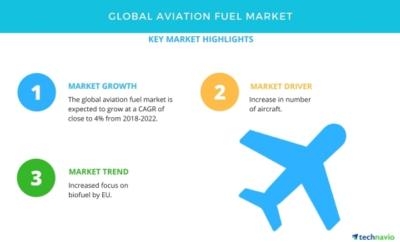Mon, Mar 19, 2018
Expected To Increase Nearly Four Percent Annually Through 2022
The global aviation fuel market is expected to grow at a CAGR of close to 4% during the period 2018-2022, according to a new market research study by Technavio.

The report presents a comprehensive research of the global aviation fuel market by product type, including ATF and aviation biofuel. The report also determines the geographic breakdown of the market in terms of detailed analysis and impact, which includes key geographies such as APAC, the Americas, and EMEA.
Recently, there has been an increase in the number of aircraft across the world. The number of people using aircraft has also increased. It is estimated that between 2005 and 2016 the number of air travelers increased by three-fourths. The growing number of passengers who commute frequently is anticipated to increase the demand for aircraft. The demand for aircraft is increasing, particularly in emerging countries such as India and China.
"The demand for aircraft will increase substantially in APAC because of the increasing air traffic in developing countries. The number of people in the middle-income group will also increase significantly over the forecast period. Also, there will also be an increase in the purchasing power of the middle-income group," said a senior analyst at Technavio for oil and gas research. "Therefore, the surge in the number of aircraft will drive the growth of the global aviation fuel market during the forecast period.”
The EU started focusing on biofuels for the aviation industry to reduce the carbon footprint of the aircraft. Some targets and policy instruments related to biofuel have already been implemented by the EU. Europe has introduced mandates for biofuels. There have also been several amendments in laws. The new amendments indicated that the share of biofuels from crops grown on agricultural land be limited to a share of 7% of the renewable energy target. This step was taken to address the problem of indirect land use for biofuels. The remaining 3% of the 10% renewable in the transport segment can be generated from other alternatives such as renewable electricity in railways and electric vehicles.
The aviation sector is linked to the price of crude oil, and its success or failure depends on the pricing of crude oil. Since July 2014, the price of crude oil was low for a prolonged period. The prices have declined continuously because of a supply-demand imbalance. The revenues of upstream oil and gas companies have decreased, which has directly affected their cash flow.
(Infographic provided with Technavio news release)
More News
From 2023 (YouTube Edition): "Ain’t Your Daddy’s Super Cub”—Don Wade Co-owned by Don and Ron Wade—the former of Don’s Dream Machines, a storied >[...]
Pilot-Rated Passenger Reported That The Pilot Did Not Adequately “Round Out” The Landing Flare And The Airplane Bounced And Yawed To The Right Analysis: The pilot state>[...]
Dead Reckoning Dead reckoning, as applied to flying, is the navigation of an airplane solely by means of computations based on airspeed, course, heading, wind direction, and speed,>[...]
Aero Linx: Lake Amphibian Club This website is created and sponsored by the Lake Amphibian Club, to help spread the word about these wonderful, versatile amphibians that can land j>[...]
“I am deeply honored to be sworn in as NASA administrator. NASA’s mission is as imperative and urgent as ever — to push the boundaries of human exploration, ignit>[...]
 Classic Aero-TV: In Praise of Alabamas Patriot Aircraft USA
Classic Aero-TV: In Praise of Alabamas Patriot Aircraft USA NTSB Final Report: Cirrus Design Corp SR22
NTSB Final Report: Cirrus Design Corp SR22 ANN's Daily Aero-Term (12.21.25): Dead Reckoning
ANN's Daily Aero-Term (12.21.25): Dead Reckoning ANN's Daily Aero-Linx (12.21.25)
ANN's Daily Aero-Linx (12.21.25) Aero-News: Quote of the Day (12.21.25)
Aero-News: Quote of the Day (12.21.25)



